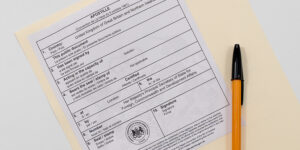Companies limited by shares usually distribute profit to their members (shareholders) in the form of cash dividend payments. Dividends are issued to all members whose shares provide dividend rights, which most do.
In this post, we discuss the rules and procedures for issuing dividends in a limited company, including how payments are worked out, the different types of dividends available, the duties of directors during the process, and the consequences of paying illegal dividends.
Key Takeaways
- Dividends are portions of post-tax profit that a company distributes to eligible shareholders
- Directors are responsible for declaring or recommending dividends based on the company’s available profits and financial health
- There may be severe consequences if a company pays dividends in excess of its ‘distributable profits’
Issuing dividends in a limited company
Company profits are distributed proportionally, based on the percentage of shares that each member holds. These distributions are often described in terms of the following:
- Dividend rate—the actual amount that is paid out in respect of each share (e.g. £1)
- Dividend yield—the dividend rate paid out per share, expressed as a percentage of the current stock value (e.g. if the dividend rate is £1 but the market value of each share is £50, then the dividend yield is 2%)
Dividend payments don’t always comprise an organisation’s entire profit. Many companies reinvest at least some of their profit back into the business. This accumulated portion of profits after dividend distributions is known as ‘retained earnings’.
- Transfer shares in your company today
- Dividend tax guide with calculator 2024-25
- Would you like a company secretary for your business – but think you can’t afford it?
Companies cannot count dividends as business expenses when calculating Corporation Tax. This is because dividends are paid from post-tax profits—the surplus income left after the company has accounted for all running costs, including Corporation Tax liability.
Furthermore, companies must pay no more in dividends than is available from profits already accumulated and eligible for this purpose. These available profits are known as ‘distributable reserves’ or ‘distributable profits’.
If a company distributes more in dividends than it has available for such purposes, the payments will be deemed unlawful or illegal dividends.
What is the procedure for paying dividends?
Broadly speaking, there are two types of dividends: final and interim. Below, we consider the general rules that apply to the payment of dividends. We also distinguish between interim and final dividends.
General rules
By law, company directors must hold a board meeting before issuing dividends. The purpose of the meeting is for the directors to ‘declare’ a dividend (either themselves or subject to approval by the members). Meeting minutes must be kept, even in companies with only one director.
Directors must create a dividend ‘voucher’ for each dividend payment. These vouchers should contain the following information:
- date of dividend payment
- amount of the dividend
- name of company
- names of shareholders eligible to receive a portion of the dividend payment
Every shareholder eligible to receive a portion of the dividend should receive a copy of the voucher. The company should also retain copies for its records.
The rules for issuing and paying dividends can vary from company to company. Any specific company procedures, conditions, or restrictions should be stated in the articles of association and, if applicable, a shareholders’ agreement.
A free dividend voucher template is available from 1st Formations.
Final dividends
Companies issue final dividends based on profits for the financial year. As such, most companies declare and pay them only once a year following approval of their annual accounts.
Directors will recommend the dividend amount. However, they must seek approval from members at a general meeting or via written resolution. At this point, the shareholders can either approve or reduce the level of dividend payment. They cannot declare a higher amount.
Upon declaring and approving the final dividends, the company must pay the agreed amount to eligible shareholders.
Interim dividends
Interim dividends can be paid out at any time during a company’s financial year rather than at the end.
Subject to any restrictions in the articles or shareholders’ agreement, directors can declare this form of dividend without seeking approval from members.
Any decision to pay an interim dividend must be on the basis of relevant interim accounts, which the company should file with Companies House.
If the directors alone declare an interim dividend, the company does not have to make the payments. The board can revoke its decision if the company’s circumstances change.
Dividend Tax Calculator
What are the duties of directors when declaring dividends?
In accordance with the Companies Act 2006 (‘the Act’), a company director ‘must exercise reasonable care, skill and diligence’ and ‘act in the way he considers, in good faith, would be most likely to promote the success of the company for the benefit of its members as a whole’.
Directors must consider these specific duties—along with their other responsibilities to the company and its members—when deciding whether to recommend a dividend payment.
As such, they should first ensure they fully understand the rules surrounding dividend payments. They must also carefully assess the company’s financial position to determine whether the level of dividend payments is appropriate.
- How to take money out of a limited company
- Set up a limited company with our All-Inclusive Package
- A guide to company shares
To understand whether a company has sufficient distributable profits, the directors should refer to the latest annual accounts circulated to members. The balance sheet in those accounts will usually show the company’s ‘retained earnings’ or ‘profit and loss reserves’—or, if it’s a micro entity, its ‘capital and reserves’.
The directors must determine the portion of those reserves qualifying as funds available to distribute as dividends. Doing so will help avoid the potential for unlawful dividends.
Aside from ensuring that dividend payments fall within the limits of available distributable reserves, it’s essential to consider the company’s overall position to meet its debts. Depending on when the latest accounts were prepared, the company’s financial health may have changed.
Consequences of issuing illegal dividends
Section 830 of the Act states that: ‘A company may only make a distribution out of profits available for the purpose’ that consists of ‘its accumulated, realised profits, so far as not previously utilised by distribution or capitalisation, less its accumulated, realised losses, so far as not previously written off in a reduction or reorganisation of capital duly made.’
Companies must also comply with the Act’s dividend procedure and documentation requirements when declaring and paying dividends.
Issuing dividends in contravention of these statutory rules can result in unlawful (illegal) dividends, the consequences of which can be severe.
- Directors who authorise dividend payments when the company has insufficient distributable profits are personally liable for any consequent shortfalls.
- Directors may also be liable if they pay dividends when the company is insolvent or if they should have reasonably foreseen cash flow problems.
- Shareholders who know (or have reasonable grounds to know) that a dividend is unlawful will be liable to repay the dividend to the extent of the unlawful amount.
- An unlawful dividend will always remain as such—it can never become lawful.
- The company may have difficulty obtaining credit by virtue of an unlawful dividend in its accounts creating the appearance of balance sheet insolvency.
Technical guidance on realised and distributable profits under the Companies Act is available from the Institute of Chartered Accountants in England and Wales (ICAEW).
How do companies pay dividends to shareholders?
Traditionally, companies paid dividends via cheque, but making payments by direct bank transfer is now more common. However, shareholders usually have a choice. Companies will generally stipulate the available payment methods in their articles of association or a shareholders’ agreement.
Sometimes, companies pay dividends in the form of additional shares, known as scrip dividends. Members often have the option to receive a dividend in cash or as additional shares.
One benefit of opting for a scrip dividend is the ability to avoid transaction costs on purchasing new shares. However, there is no tax advantage because HMRC treats scrip dividends the same way as cash dividends for taxation purposes.
Dividend payments have an annual tax-free allowance of £500 (applicable to the 2024-25 and 2025-26 tax years). After this, they are subject to dividend tax according to the shareholder’s Income Tax band:
- 8.75% at the basic rate
- 33.75% at the higher rate
- 39.35% at the additional rate
It is worth mentioning that some companies also offer dividend reinvestment plans (DRIPs) that provide members with more shares instead of cash. However, there are some important technical differences between drip and scrip dividends.
Multiple classes of shares and dividends
Some companies offer different classes of shares for the purpose of organising a specific distribution of dividend payments. For example:
Ordinary shares
Companies can separate ordinary shares into alphabet classes, assigning letters to differentiate them. For example, “A” ordinary shares, “B” ordinary shares, “C” ordinary shares”, etc. The company can then apply a different dividend rate to each class of alphabet shares.
Preference shares
Preference shares have a fixed dividend rate and are payable before other share classes. This means that they take precedence over ordinary share dividends. After paying preference shareholders, companies will distribute any remaining amount between the holders of ordinary shares.
Cumulative preference shares
These are similar to preference shares. However, they provide that if a dividend payment is missed or not paid in full (e.g., due to insufficient distributable profits), the shareholder will receive any shortfall in a future dividend payment when sufficient distributable reserves exist.
Deferred ordinary shares
Holders of these types of shares will not receive any dividend payment until holders of the other shares have received a minimum dividend. They will receive the same dividend rate as other shareholders.
Non-dividend paying shares
This share class excludes its holders from receiving dividend payments. However, they will carry other shareholder rights, such as voting at meetings, the power to remove directors, and the right to capital upon winding up.
Requirements when creating multiple share classes
Any decision to create new classes of shares to distinguish dividend rights requires approval by ordinary resolution at a board meeting or general meeting. The correct course of action depends on whether directors can make such decisions with or without shareholder approval.
The minutes of the meeting should reflect the approval and be filed accordingly.
If necessary, the members must also amend the articles of association accordingly (e.g. if they do not permit the creation of new share classes).
Dividend waivers
On occasion, a shareholder may choose not to accept a dividend payment. This decision is known as a dividend waiver.
Shareholders may decide to waive dividends for the company’s benefit, keeping money in the business to reinvest in operations or growth. Depending on their objectives, this may be preferable to receiving payments and losing some of the profit through the consequent taxation of dividends.
A Deed of Waiver should be used to give effect to a dividend waiver. In the case of final dividends, the waiver should be put in place before the dividend is declared. Regarding interim dividends, the waiver should be set up before payment.
Thanks for reading
Please feel free to comment below if you have any questions. For more limited company guidance and small business advice, explore the 1st Formations Blog.
Please note that the information provided in this article is for general informational purposes only and does not constitute legal, tax, or professional advice. While our aim is that the content is accurate and up to date, it should not be relied upon as a substitute for tailored advice from qualified professionals. We strongly recommend that you seek independent legal and tax advice specific to your circumstances before acting on any information contained in this article. We accept no responsibility or liability for any loss or damage that may result from your reliance on the information provided in this article. Use of the information contained in this article is entirely at your own risk.









Join The Discussion
Comments (8)
Hi, my ex husband and I are joint directors and 50% shareholders in a family business. (He has ordinary shares and I have ordinary A shares)
He has withheld my dividend payments for tax years 22/23 and 23/24. Previously we received equal dividends. Since our separation in 2019 I haven’t been invited to any board meetings or been involved in any agreements or declarations etc. I have recently received minutes from directors meetings that I haven’t been involved with, these minutes state that I was present and some even state that I had been instructed to record the minutes. Would this be considered fraud/financial misconduct?
This January, he agreed to pay a dividend as part of our financial settlement, the company accountant filed our tax returns including this dividend but I haven’t received the payment. I am now liable for the tax when I haven’t actually received the funds. Is there anything I can do?
Thank you for your time
Thank you for your kind comment.
Unfortunately as we are not regulated to provide legal advice, we are unable to provide advice on specific scenarios. We would recommend contacting a solicitor for further assistance.
Please accept our apologies for any inconvenience caused.
Kind regards,
The 1st Formations Team
in a case of where five of us are shareholders but 2 are dormant , they do not participate in any company activities in any form, if it is the point of sharing the dividends, must we share equally or something.
Thank you for your kind enquiry, Ayuel.
In general terms, unless the shares held by the 2 “dormant” shareholders belong to a different class which has different dividend rights to those shares held by the other shareholders, you would normally expect equal treatment as regards the payment of dividend (in other words, the 2 “dormant shareholders” should receive the same amount of dividend per share as the other shareholders). This is because all shares of the same class must be treated equally to one another. If this is not a situation you want, you may want to look at introducing multiple share classes.
We trust this information is of use to you.
Kind regards,
The 1st Formations Team
I have a percentage of shares in a limited company that have typically been paid by a. monthly dividend payment on profit earned after corporation tax is deducted this has been the case for 10+ years.
I have now been told by the company’s owner and main shareholder that he is going to withhold dividend payment’s even though the company is making a profit.
I own shares in the business, Is this correct?
Thank you for your kind enquiry.
As a general rule, there’s no strict requirement that profit has to be paid to the shareholders of the company. Oftentimes, profit might be kept within the company, for example for the purposes of reinvesting in the company’s operations. This is called retained earnings. Further, it should be noted that it is for the directors to determine whether a company can declare a dividend (after all, they are normally liable, if the company pays a dividend it should not have). So, in a strict sense it is not incorrect to say that company might decide not to pay a dividend, although this is of course subject to the articles of association, and any shareholder agreements in place, etc.
We trust this information is of use to you.
Kind regards,
The 1st Formations Team
I have just been paid an interim dividend. However it was close to six weeks after the announcement, and five weeks after the first person received their payment.
Some were paid by cheque and some by BACS but this was done over a period of five weeks, ie we were not all paid at the same time
you may or may not be able to help me but thanks for taking the time to read this
J DAVIES
Thank you for your kind enquiry, John.
Generally speaking, shareholders may have a preference as to how they receive their dividends, so it’s not uncommon for some shareholders to receive payment in one form and other to receive payment in another. For example, the model articles of association state that any dividend must be paid by a bank transfer, cheque, or another means as agreed by the directors (or a combination of any of these).
As regards the timescales of the payment, we are not aware of a specific timetable in which companies must pay their dividends. However, we would expect shareholders to be paid at the same time. It is not usually possible to vary the payment terms between shareholders unless a share structure is put in place that permits this variability – for example, multiple share classes.
We trust this information is of use to you.
Kind regards,
The 1st Formations Team